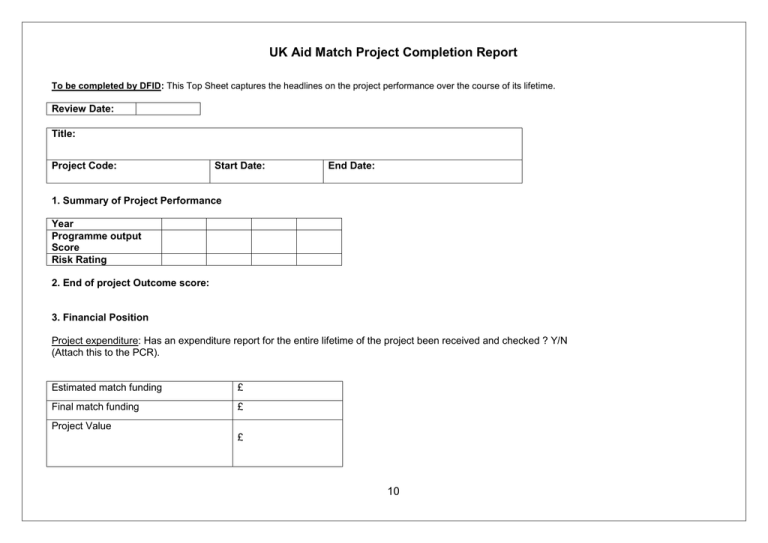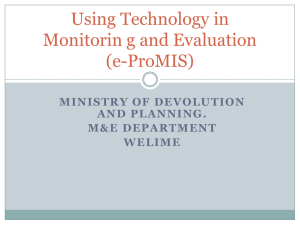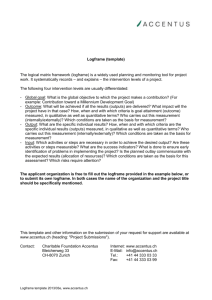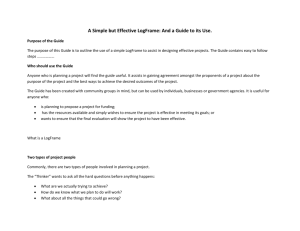Project completion report template
advertisement

UK Aid Match Project Completion Report To be completed by DFID: This Top Sheet captures the headlines on the project performance over the course of its lifetime. Review Date: Title: Project Code: Start Date: End Date: 1. Summary of Project Performance Year Programme output Score Risk Rating 2. End of project Outcome score: 3. Financial Position Project expenditure: Has an expenditure report for the entire lifetime of the project been received and checked ? Y/N (Attach this to the PCR). Estimated match funding £ Final match funding £ Project Value £ 10 Project dates Extensions/ amendments Log-frame revisions (dates and quest numbers of revised logframe) Total project spend 4. Summary of Communications Achievements Appeal name Appeal dates Main communication partners Number of donors to appeal Number of Opportunities to view – Appeal Number of Opportunties to view – Report back (date and comms partner?) i) ii) Information from initial six month report: Information from first annual report and any subsequent reports: 5. Follow up actions required following closure 10 To be completed by UK Aid Match partner: This template is used for the final annual report of a project and covers progress made during the whole of the project life-time. Please complete each section of the review template. Expand boxes as required. Guiding notes are provided in red italics. Please delete guidance notes before submitting. The Annual Review assesses and rates outputs using the following rating scale. Description Outputs substantially exceeded expectation Outputs moderately exceeded expectation Outputs met expectation Outputs moderately did not meet expectation Outputs substantially did not meet expectation Scale A++ A+ A B C A: SUMMARY Complete the summary sheet with highlights of progress, lessons learnt and action taken on previous recommendations over the course of the review period. Name of grant holder: Project title: Project Value: PCR Review Date: % of Match Funding: Start Date: End Date: Summary of main lessons learnt during project 10 B: PERFORMANCE AND CONCLUSIONS B.1 Outcome statement: Add the outcome statement from your logframe. B.2 Performance Include each outcome indicator and add more rows as required. For year 1 and 2 milestones, just state whether the achievement was on track or not. In the last two columns state the end of project target and what was achieved, eg. target: 80% of households have increased assets; achievement: 60% of households have increased assets. Indicator Baseline Year 1 milestone achievement Year 2 milestone achievement End of project target End of project achievement Provide a brief narrative to explain progress towards targets, highlighting key achievements and account for slippage, and/or exceptional performance. 10 C: DETAILED OUTPUT SCORING For each output, add the output statement, and a score for progress on the output using the A++ to C scale on p. 1. Add boxes (C 1. – C 4) for each output in your logframe as required. The impact weighting figure and risk rating should match the those shown on the logframe. C.1 Output statement Output number According to logframe Output Score A++ to C Risk: Low/Medium/High Impact weighting (%): C.2 Add/delete rows and columns as required. For year 1 and 2 milestones, just state whether the achievement was on track or not. In the last two columns state the end of project target and what was achieved, eg. target: 80% of households have increased assets; achievement: 60% of households have increased assets. Indicator Baseline Year 1 milestone achievement Year 2 milestone achievement End of project target End of project achievement C.3 Comments on progress towards output targets Provide a narrative explanation to justify the score above, highlighting key achievements and accounting for slippage, and/or exceptional performance. 10 C.4 Describe how have you addressed feedback from DFID on this output following your last report or 6 monthly review meeting? (if applicable) Add boxes C. 1 – C. 4 for each output in your logframe as required. D: VALUE FOR MONEY For each section please explain what the project has done and give examples. D.1 Economy: What has been done over the lifetime of the project to drive down costs of project inputs while maintaining the required standards of quality? Include staff, consultants, raw materials and capital to produce outputs, and references to the use of any relevant unit cost benchmarks. D.2 Efficiency: How have you ensured that resources (inputs) have been used efficiently over the lifetime of the project to maximise the results achieved? 10 Include references to the use of any relevant cost comparisons (benchmarks) at the output level (e.g. standard training cost per trainee); and any efficiencies gained from working in collaboration with others. D.3 Are there multiplier effects from this project? Include things which have resulted from, or are likely to result from the project, for example, the potential for leveraging additional funds to achieve development objectves, longer term or larger scale implementation of the intervention, or replication of approaches and results. E. SUSTAINABILITY E.1 What have you done during the project to ensure that positive changes to peoples’ lives achieved through the project will be sustained when the project ends ? 10 E.2 If the project is introducing new or improved services that need to continue after the project ends, what have you done during the project to ensure the sustainability of the service? If applicable, please explain and provide examples: E.3 (If not covered by questions E1 and E2 above): What are the on-going needs of the target communities relevant to the project intervention, and how will these be met ? If applicable, please explain and provide examples: F. EQUITY (GENDER & DIVERSITY) F.1 How have marginalised groups benefitted from your project (e.g. landless, disabled, elderly)? F.2 How have women and girls benefitted ? 10 F.3 How have beneficiaries participated in decision making in this project? G: RISK G.1 What were the main risks which you identified and realised over the life-time of the project, and what actions did you take ? Refer to your agreed project risk matrix (if applicable) and the key risks identified in your progress reports. G.2 Describe any incidents of alleged fraud or corruption which took place during the project (If applicable. Please note that you should inform us of any incidents as soon as they arise – do not wait for a formal review to inform us of these) G.3 Quality of financial management What have you done during this reporting period to ensure that local delivery partners manage project funds transparently to achieve good value for money? Include any audits or spot checks of local delivery partners which you have undertaken during the reporting period and key findings. 10 G.4 What do you intend to do with project assets ? Attach asset register (if applicable) H: MONITORING & EVALUATION H.1 What have you learnt during the project about how best to achieve project outputs and outcome from the following sources of information ? Routine project monitoring Internal or independent evaluations/reviews you have commissioned (please attach these to yourproject completion review). Beneficiary feedback Other evidence/research about the effectiveness of the type of project you are undertaking H.2 If you were to start the project again , what would you do differently ? 10 If applicable, what will you do differently in future interventions as a result? Do you intend to undertake any further evaluation of this project? If so, please provide the information on what this evaluation will cover, who will be conducting it, and when the findings are likely to be available? I : COMMUNICATIONS Summary of Communications Achievements Appeal name Appeal dates Main communication partners Number of donors to appeal Number of Opportunities to view – Appeal Number of Opportunties to view – Report back (date and comms partner?) 10






